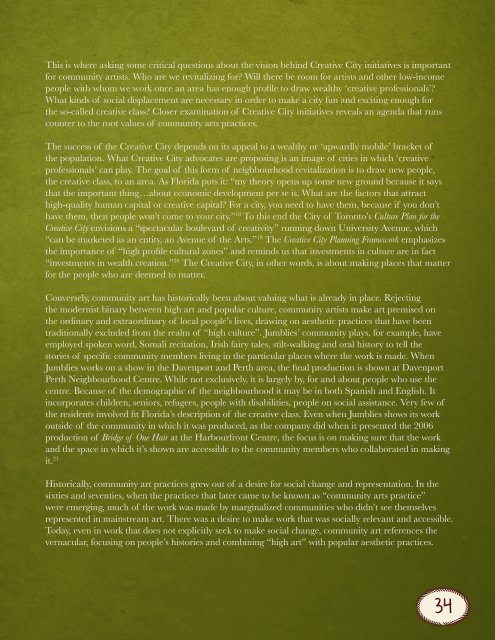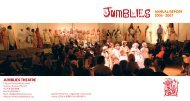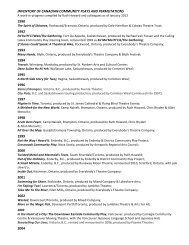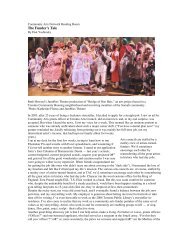publication - Jumblies Theatre
publication - Jumblies Theatre
publication - Jumblies Theatre
- No tags were found...
You also want an ePaper? Increase the reach of your titles
YUMPU automatically turns print PDFs into web optimized ePapers that Google loves.
This is where asking some critical questions about the vision behind Creative City initiatives is importantfor community artists. Who are we revitalizing for? Will there be room for artists and other low-incomepeople with whom we work once an area has enough profile to draw wealthy ‘creative professionals’?What kinds of social displacement are necessary in order to make a city fun and exciting enough forthe so-called creative class? Closer examination of Creative City initiatives reveals an agenda that runscounter to the root values of community arts practices.The success of the Creative City depends on its appeal to a wealthy or ‘upwardly mobile’ bracket ofthe population. What Creative City advocates are proposing is an image of cities in which ‘creativeprofessionals’ can play. The goal of this form of neighbourhood revitalization is to draw new people,the creative class, to an area. As Florida puts it: “my theory opens up some new ground because it saysthat the important thing…about economic development per se is, What are the factors that attracthigh-quality human capital or creative capital? For a city, you need to have them, because if you don’thave them, then people won’t come to your city.” 18 To this end the City of Toronto’s Culture Plan for theCreative City envisions a “spectacular boulevard of creativity” running down University Avenue, which“can be marketed as an entity, an Avenue of the Arts.” 19 The Creative City Planning Framework emphasizesthe importance of “high profile cultural zones” and reminds us that investments in culture are in fact“investments in wealth creation.” 20 The Creative City, in other words, is about making places that matterfor the people who are deemed to matter.Conversely, community art has historically been about valuing what is already in place. Rejectingthe modernist binary between high art and popular culture, community artists make art premised onthe ordinary and extraordinary of local people’s lives, drawing on aesthetic practices that have beentraditionally excluded from the realm of “high culture”. <strong>Jumblies</strong>’ community plays, for example, haveemployed spoken word, Somali recitation, Irish fairy tales, stilt-walking and oral history to tell thestories of specific community members living in the particular places where the work is made. When<strong>Jumblies</strong> works on a show in the Davenport and Perth area, the final production is shown at DavenportPerth Neighbourhood Centre. While not exclusively, it is largely by, for and about people who use thecentre. Because of the demographic of the neighbourhood it may be in both Spanish and English. Itincorporates children, seniors, refugees, people with disabilities, people on social assistance. Very few ofthe residents involved fit Florida’s description of the creative class. Even when <strong>Jumblies</strong> shows its workoutside of the community in which it was produced, as the company did when it presented the 2006production of Bridge of One Hair at the Harbourfront Centre, the focus is on making sure that the workand the space in which it’s shown are accessible to the community members who collaborated in makingit. 21Historically, community art practices grew out of a desire for social change and representation. In thesixties and seventies, when the practices that later came to be known as “community arts practice”were emerging, much of the work was made by marginalized communities who didn’t see themselvesrepresented in mainstream art. There was a desire to make work that was socially relevant and accessible.Today, even in work that does not explicitly seek to make social change, community art references thevernacular, focusing on people’s histories and combining “high art” with popular aesthetic practices.34








